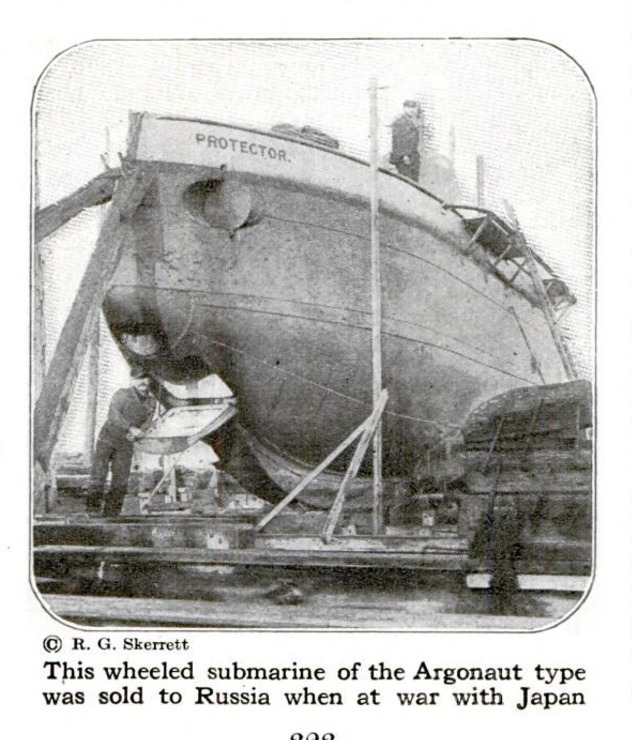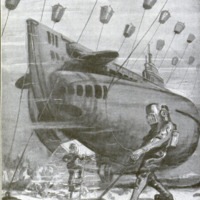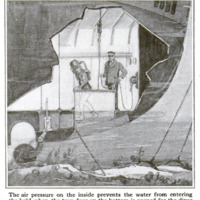Sea tank
Contenuto
-
Titolo
-
Sea tank
-
Article Title and/or Image Caption
-
Now Comes the Sea Tank. Did the Italians blow up the Austrian dreadnought in Pola with an American wheeled submarine?
-
Caption 1: The divers are cleaning away the mines. They leave and enter the submarine by a door, just as they would a house. What keeps the water out of the boat? Just air, but at such a pressure that it pushes the water back. Wheels enable the boat to roll on the ocean bed
Caption 2: This wheeled submarine of the Argonaut type was sold to Russia when at war with Japan
-
Caption 3 : The air pressure on the inside prevents the water form entering the hold when the drap door on the bottom is opened for the diver
-
extracted text
-
WHEN Lieutenant Commander Pel-
legrini forced his way into the
harbor of Pola and sank at least
one of Austria's biggest dreadnoughts,
what sort of craft did he command?
The dispatches say that he used a “sea
tank,” and that “the boat was forty feet
long, six feet wide, and propelled by
electricity. There is an endless rotary
chain around the vessel fitted with barbs
which cut nets and other obstacles, like
the land tanks. The craft has two tor-
pedo tubes.”
These particulars may be correct, and,
again, they may be nothing more than
governmental camouflage to cover up
the laxity at Pola, which permitted the
Italians to get by the guardship at the
harbor mouth, to
thread a maze of
cunningly - planted
mines, and, finally, |
to break through
an inner defense |
consisting of a bar-
rier net of wire
rope. But if Lieu-
tenant Commander |
Pellegrini did use
a so-called “sea |
tank,” its success
was spectacular,
and the public,
both lay and tech-
nical, is naturally
curious to know |
what new order of
torpedo - boat has
been evolved for
naval warfare.
A bit of hitherto |
unpublished history may help us to a:
fairly accurate idea of the real nature of
the sea tank in question. As in the case
of the land tank, we may find that the
type is substantially a duplication of an
American invention conceived primarily
to facilitate commercial salvage opera-
tions under water. Pellegrini’s sea tank
was, in all likelihood, a modification of
the wheeled submarine Argonaut built
by Simon Lake in Baltimore in 1897.
The Argonauf was a stumpy cigar-
shaped vessel of steel, thirty-six feet long,
having a maximum diameter of nine feet.
When fully submerged, her displacement
was about fifty-nine tons. The boat was
built to travel on the surface or to roll
alonwon the oceanbed, and two bir cog-
rimmed driving
wheels, driven by
a gasoline motor
through suitable
gears, propelled her
on the sea floor. By
regulating the un-
dersea crait’s dead
weight with water
ballast the pressure
or grip upon the
bottom could be
adjusted. The
front compartment
of the old Argonaut
was a compressed
air chamber or air
lock that is used in
tunneling beneath
the rivers. The air
in the chamber was
compressed to such
a degree that it
prevented the water from coming in
through an open hatch while a diver
could step from the chamber right out
upon the bottom of the sea.
_ The purpose of the Argonaut was to
make salvage operations safer and easier
by furnishing the divers with a sub-
merged base from which to work un-
hampered
by weather |
conditions |
at the sur-
face. The |
Argonaut
cruised
upon and |
below the
waters of
Chesa-
peake Bay |
in 1898
and also |
covered |
many hun-
dred miles
both under
and above
water. The
following
extract
from the |
vessel's |
log, dated
July 28
of that
year, is
very sug-
gestive: |
“We were desirous of making a search for the
cables which connected with the mines guarding
the entrance to the harbor at Hampton Roads,
but could not obtain permission from the author-
ities, who were afraid we might accidentally sever
them, which would, of course, make their entire
system of defense useless.”
However, Mr. Simon Lake had a
cable laid upon the bottom at another
point, and then approached it from a
distance after taking his bearings by
compass. The Argonaut rolled along
with the door of the diving compartment
open, and succeeded without any trouble
whatever in hooking up the cable and
bringing it into the chamber, where it
was cut to complete the demonstration.
Early in 1906, Mr. Lake was in Europe,
and went to Rome to interest the Italian
Ministry of Marine in his naval sub-
marines which he had developed after
building the Argonaut. Mr. Lake laid
much emphasis upon the distinctive
features of his type embodied in the
diving compartment and his improved
form of bottom wheels. The Minister of
Marine listened for a while and then
suavelv ssid to My. Lake:
“But,
my dear
sir, our
shores
dip too
quickly
and sud-~
denly to
great
depths to
make
these
wheels of
value in
defending
our sea-
coasts.”
Mr. Lake
promptly
rejoined:
“Yes, that
is quite
true, Your
Excellen-
ey, with
the excep-
tion of the
Adriatic
seaboard
which lies
nearest to your likeliest foe, Austria.
From Ancona northward and then east-
ward to the neighborhood of Pola the
120-foot Jerk line extends off shore any-
where from five miles to many times that
distance, and that sandy sea-bed is just
the area within which a submarine with
bottom wheels could do its best work in
protecting the Gulf of Venice from a
hostile naval force.”
Can it be that the Italians borrowed
Mr. Lake's suggestion? This ingenious
American has shown more than once how
a couple of his submarines could sweep
mine fields with little fear of detection.
Divers could cut nets easily without dis-
turbing in the least the supporting surface
buoys that might otherwise betray the
presence of the attacking submarine.
-
Autore secondario
-
Robert G. Skerrett (writer)
-
Lingua
-
eng
-
Data di rilascio
-
1918-09
-
pagine
-
322-324
-
Diritti
-
Public Domain (Google digitized)
-
Archived by
-
Filippo Valle
-
Alberto Bordignon (Supervisor)






